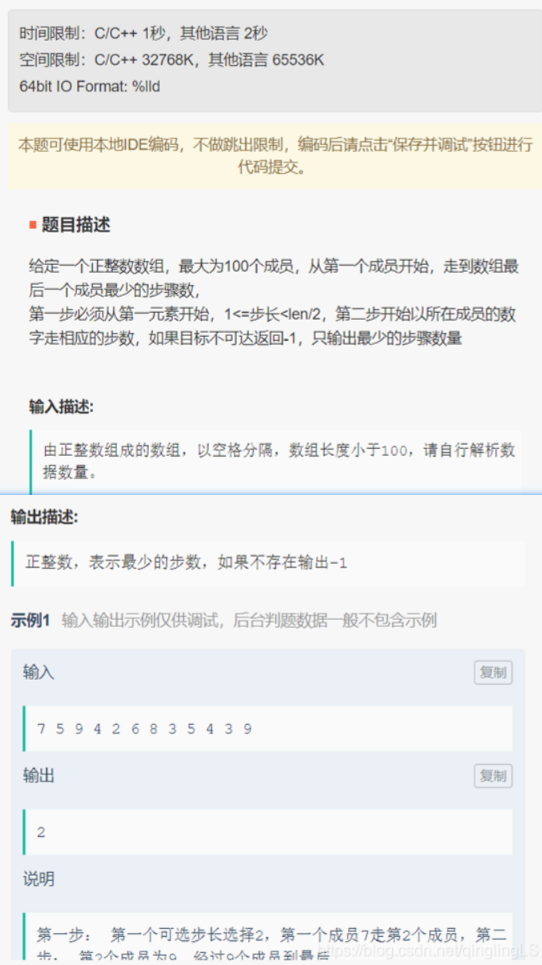■题目描述
给定一个正整数数组,最大为100个成员,从第一个成员开始,走到数组最后一个成员最少的步骤数,
第一步必须从第一元素开始,1<=步长<len/2, 第二步开始以所在成员的数字走相应的步数,如果目标不可达返回-1,只输出最少的步骤数量

- 思路1:从前往后进行遍历,第一步走1步,求解;第一步走2步,求解,第一步走…… 走
(len/2)步,分别求解,如果可以达到终点,则记录步数,如果步数足够小,则保存。这样复杂度是O( n 2 n^2 n2)。 - 思路2:从后往前遍历,指针记录距离尾部距离,例如:nToTail=0,指针在9位置;nTotail=1,指针在3位置,由于3!=nToTail而且大于nToTail,不计算,指针继续前移;同样,指针一直移动,直到
nToTail=6此时data[len-1-6]=6,保存此时的步长并继续向前移动,直到找到表头为止;此时,指针移动到nToTail=9,data[len-1-9]=9,所以更新最大步长为9;继续找到表头,无符合的数据了 - 从刚才找到的最大步长开始继续往前找,令指针指向
data[len-1-9]位置,更新距离为0。此时,len-1-9已经小于len/2所以可以一步到位;否则应该从9开始,继续往前找,直到找到一个步长,可以从后往前越过len/2的位置。
可以看到,思路2的耗时明显很少,采用思路2进行编码
PS:会不会有从前往后走能走通,但是从后往前走走不通的情况呢:
考虑到类似:1,3,1,2,120,1,0的输入,从后往前走,会遇到120,此时会走不通,但是走到2的时候,由于走两步到倒数第二个1,所以120并不影响。(这个证明并不严谨,大概是这个意思)
代码:
#include <iostream>
using namespace std;
/**********************************************/
// 给定一个正整数数组,最大为100个成员,从第一个成员开始,
// 走到数组最后一个成员最少的步骤数,
// 第一步必须从第一元素开始,1 <= 步长 < len / 2,
// 第二步开始以所在成员的数字走相应的步数,如果目标不可达返回 - 1,
// 只输出最少的步骤数量
int FindEnd(int* numbers, int length) {
if (numbers == nullptr || length <= 1)
{
return -1;//不存在,输出-1
}
int nIndex = length - 1; // 尾部指针
int nToTailDist = 0; // 指针距离尾部距离
int nMaxStep = 0; // 最大距离
int nStep = 0; // 当前走的步数
while (true)
{
if (nToTailDist == numbers[nIndex] && nMaxStep < nToTailDist)
{
// 找到可达步长
nMaxStep = nToTailDist;
}
nIndex--; // 移动指针
nToTailDist++;
if (nIndex < 0)
{
if (nMaxStep ==0)
{
// 如果该回合没有找到一个最大步数,说明卡住了,没有可达步数
return -1;
}
nStep++;
nIndex = length - 1 - nMaxStep;
if (nIndex <= length / 2)
{
if (nIndex>0)
{
nStep++;
return nStep;
}
else {
return nStep;
}
}
nToTailDist = 0;
nMaxStep = 0;
}
}
return -1;
}
void Test(int v1,int v2,const char*name) {
if (v1 == v2) {
cout << name << ": pass" << endl;
}
else {
cout<<name << ": FAIL!!" << " should be " << v2 << endl;
}
}
void Test_FindEnd() {
// 标准测试用例:走2步到9,从9到尾部结束
// 答案:2
int test1[12] = {
7,5,9,4,2,6,8,3,5,4,3,9 };
Test(FindEnd(test1, 12), 2, "test1");
//测试用例2:正好从第一步9步(len/2)走到9,然后到终点
// 答案:2
int test2[19] = {
1,2,3,4,5,2,5,6,7,9,4,2,6,8,3,5,4,3,9 };
Test(FindEnd(test2, 19), 2, "test2");
//测试用例3:一步就可以结束
// 答案:1
int test3[10] = {
9,4,2,6,8,3,5,4,3,9 };
Test(FindEnd(test3, 10), 1, "test3");
//测试用例4:没有路线可以到尾部1
// 答案:-1
int test4[4] = {
9,4,10,12};
Test(FindEnd(test4, 4), -1, "test4");
//测试用例5:没有路线可以到尾部2
//答案:-1
int test5[12] = {
1,2,4,2,1,1,100,120,1,2,3,4 };
Test(FindEnd(test5, 12), -1, "test5");
//测试用例6:异常输入
// 答案:-1
int *test6 = nullptr;
Test(FindEnd(test6, 1), -1, "test6");
//测试用例7:最短步数:从index=3走到4,再走到1,只需要3步
// 答案:3
int test7[10] = {
3,1,1,1,4,1,1,1,1,1};
Test(FindEnd(test7, 10), 3, "test7");
//测试用例8:
// 答案:1
int test8[2] = {
1,1 };
Test(FindEnd(test8, 2), 1, "test8");
//测试用例9:异常测试
// 答案:-1
int test9[1] = {
1 };
Test(FindEnd(test9, 1), -1, "test9");
// 考虑输入0的情况
int test10[7] = {
1,3,1,2,120,1,0 };
Test(FindEnd(test7, 7), -1, "testA");
}
int main()
{
Test_FindEnd();
}